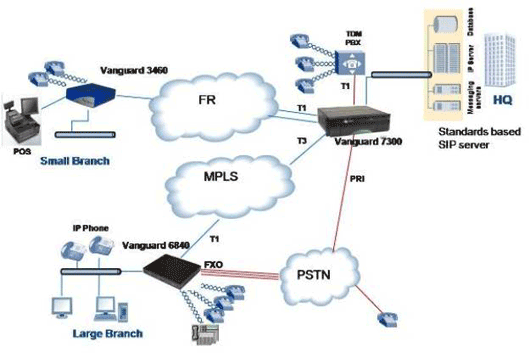Enterprise IP Telephony Solution Overview By using MPLS or Frame Relay networks, which provide the robustness and quality of service that voice over IP requires, enterprises can now go ahead and deploy IP telephony across the enterprise. Voice, data, and video convergence over a single IP network streamlines the infrastructure, reduces capital and operating costs and opens the network for new application opportunities. Voice enables multimedia applications, such as unified communications, web-enabled contact centers, presence, and videoconferencing. IP telephony enables remote offices to fully participate and profit from advanced multimedia applications, without having to make large capital investments or build separate networks. It also simplifies deployment, reconfiguration and trouble shooting remotely, and cost-effectively.
Vanguard Networks has provided voice solutions to enterprises for over 10 years, since the times of TDM, voice over Frame Relay, H.323, and now SIP. SIP enables complete IP telephony services from trusted service providers. SIP-based IP telephony services provide high-quality voice at lower cost, complete integration with the Web, email and other messaging systems, and high reliability –and they are here today. SIP is the standard, open protocol that has been accepted as the foundation of VoIP and of next generation communication services.
Our long experience with real-life networks has allowed us to adapt our SIP implementation successfully to leading vendors’ SIP implementations. This capability frees the enterprise to pick and chose best of breed IPPBX, SIP Phones, application servers, and other SIP-compliant systems. The Vanguard Networks' Multiservice routers and Access Services Gateways ensure that these systems will talk to each other and are fully VoIP ready. Vanguard Networks has a field proven solution to integrate IP telephony networks, supporting analog and digital PBXs, phones, faxes, IP PBXs, and IP phones as well as multiple telephony signaling schemes (PRI, BRI, R2, etc) and conversion from one standard to another. An office may use analog phones, with or without a PBX or key system, fax, computers, H.323 videoconferencing or SIP phones. A Vanguard Networks’ router will handle them all, flexibly converting and routing to the PSTN, SIP Server, over Broadband, Frame Relay or MPLS. Voice and data quality, security, and reliability remain at the highest level. ApplicationsCorporate Multisite IP TelephonyIn this application, enterprise calls can remain on the enterprise data network, whether Frame Relay or IP/MPLS. This leverages the converged network environment and the investments the enterprise has made both in a quality data network and existing telephony equipment, and reduces toll charges from service providers. Existing analog or digital phones or SIP telephones can be used. This application may support hundreds or thousands of users per site, connecting a mix of digital PBX, analog phones and IP phones with one or more SIP servers at the headquarters’ locations. Regional branches are autonomous but enjoy access to advanced features and applications. To users the multisite network feels like one unified corporate network. 
Remote Branch Office IP TelephonyYou can extend SIP voice and data services to all your business locations, typically 5 to 100 users per site, cost-effectively and at your own pace. You may decide to equip some branches with IP phones while other locations may stay with analog sets or a legacy PBX while providing a seamless employee and customer experience. Single-site IP Telephony (SIP Trunking)Enables smaller businesses to appear and perform like much larger ones and enjoy all the cost advantages, efficiencies, and productivity of converged voice and data services. A SIP trunk is a service offered by an ITSP (Internet Telephony Service Provider) that permits businesses that have a legacy or IP PBX installed to use Voice-over-IP (VoIP) also outside the enterprise network by using the same connection as the Internet connection. SIP phones and other SIP devices can be connected to a service provider via a SIP trunk line. This all-IP configuration can save costs on gateways, toll charges, and the costs of a separate PSTN connection. Benefits- Improve business productivity and enable new services.
- Allows convergence of corporate local and long distance voice, as well as data, eliminating toll charges and reducing operational costs.
- Speeds up and simplifies change administration, reducing administrative costs with the adoption of SIP phones and convergence.
- Enhances the ability of remote technical support to provide faster user moves, adds, and changes.
- Protects investments in existing telephones and communications gear, enabling adoption of IP Telephony on your own timeline.
|